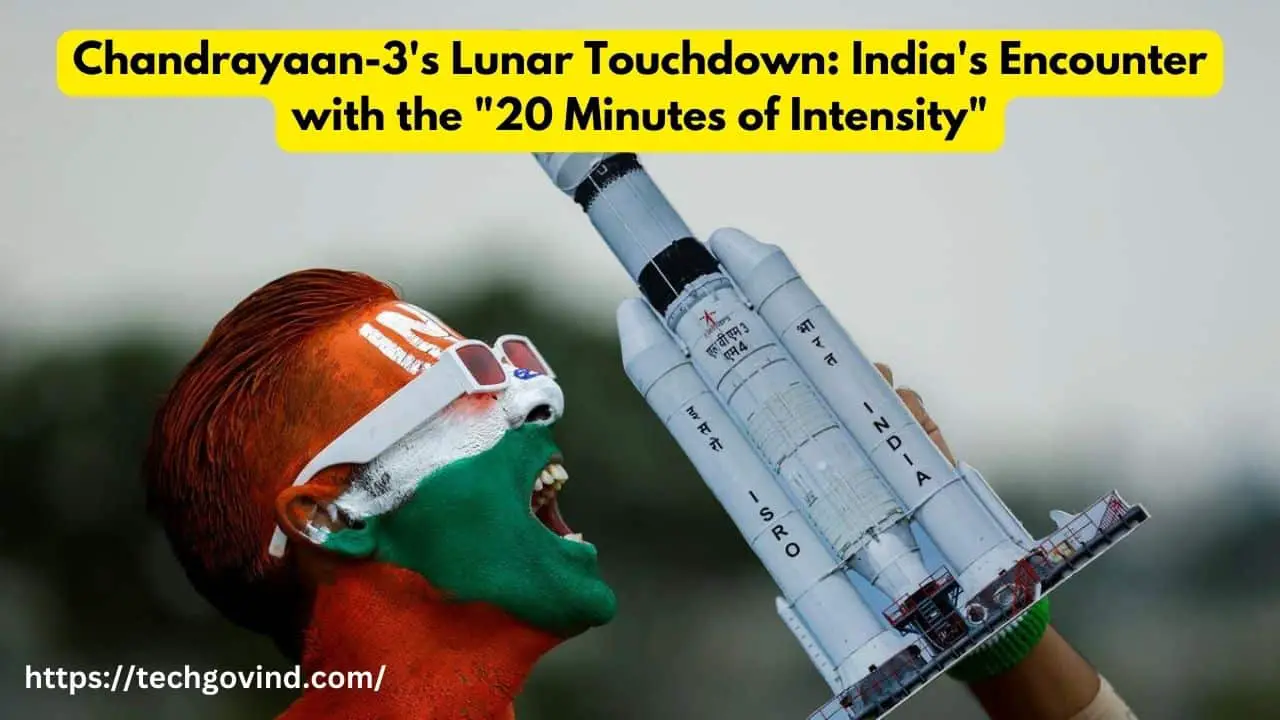New Delhi – As the week progresses, all eyes are on India’s forthcoming landmark event. In a matter of days, the entire nation will collectively hold its breath for an intense period of approximately twenty minutes.
During this time frame, the Vikram lander will meticulously strive to achieve a seamless touchdown on the moon’s surface, presenting an event laden with suspense and anticipation. Chandrayaan-3’s Lunar Touchdown: India’s Encounter with the “20 Minutes of Intensity”

With India’s Chandrayaan-3 mission poised to etch its name in the annals of history, the spotlight is on the audacious endeavour of ensuring a soft lunar landing for the Vikram Lander.
Accompanying it is the Pragyaan rover, securely nestled within. The chosen landing site is none other than the moon’s southern pole. The climactic final stretch of roughly twenty minutes has aptly been coined as “twenty minutes of apprehension,” akin to the nerve-wracking conclusion of a T-20 cricket match.
Chandrayaan-3’s Journey and landing process in Space
After a magnificent liftoff, ISRO’s Bahubali rocket, also known as the Mark-3 launch vehicle, flawlessly positioned Chandrayaan-3 into orbit. Chandrayaan-3 performed a series of elliptical Earth orbits, gradually increasing its velocity.
On August 1, Chandrayaan-3 commenced its 384,000-kilometer journey toward the Moon. By August 5, the spacecraft gracefully entered lunar orbit and achieved a stable configuration. It remained stationary in the Moon’s orbit for several days.
A pivotal and intricate manoeuvre took place on August 17, entailing the separation of the propulsion module and the Vikram lander, which housed the Pragyaan rover. This was carried out while the satellite occupied an orbit measuring 153 km by 163 km. The propulsion module continued its lunar orbit with the same dimensions.
Following this, the Vikram lander gradually descended closer to the lunar surface, transitioning into a 134 km by 25 km elliptical orbit in preparation for the powered descent. This operation had been successfully executed during India’s Chandrayaan-2 mission.
The day of landing brought forth a nerve-racking phase of twenty minutes, often referred to as the “T-20” period. Following commands from Bengaluru, the Vikram lander initiated its descent from an altitude of 25 km.
During the powered descent, the Vikram lander accelerated toward the lunar surface at a velocity of 1.68 km per second, roughly 6048 km per hour – approximately ten times the speed of an aeroplane.
The lander subsequently engaged its engines to decelerate, gradually orienting itself vertically in relation to the Moon’s surface. This phase, known as the “rough braking phase,” endured for roughly 11 minutes.
Transitioning to the “fine braking phase,” the Vikram lander underwent further adjustments to align itself vertically, preparing for a controlled landing.
It’s important to note that during the Chandrayaan-2 mission, an issue arose during the fine braking phase, leading to an uncontrolled descent and eventual crash of the Vikram lander.
At an altitude of 800 meters above the lunar surface, both horizontal and vertical velocities were nullified, allowing the lander to hover momentarily while surveying the landing zone.
Continuing its descent, the Vikram lander hovered again at 150 meters above the surface, capturing images to detect potential hazards and identify the most suitable landing site.
The lander ultimately made a gentle touchdown on the lunar surface, employing two engines designed to withstand an impact of up to 3 meters per second (roughly 10.8 km per hour).
Upon detecting contact with the lunar surface, the engines were disengaged, concluding the intense twenty-minute period.
Subsequent to landing, any lunar dust that was stirred up, known as regolith, settled, and the landing ramp extended. The Pragyaan Rover was deployed with care, commencing its exploratory mission.
Once it reached the lunar surface, the Pragyaan Rover gained autonomy, while the Vikram lander and the rover exchanged images, transmitting India’s first-ever lunar selfies back to Earth.
With the successful landing accomplished, the stage was set for significant scientific endeavors. Both the Vikram lander and the rover operated on solar power and were engineered for a lifespan of one lunar day, equivalent to 14 Earth days.
Barring unforeseen complications, India was on the verge of becoming the fourth nation to achieve a soft landing on the Moon.
